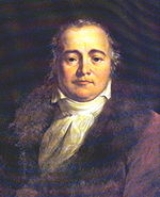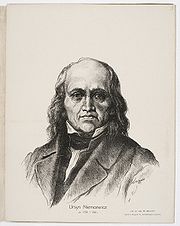
Julian Ursyn Niemcewicz
Encyclopedia
Julian Ursyn Niemcewicz (Skoki, near Brześć, February 6, 1758 – May 21, 1841, Paris
) was a Polish
poet, playwright and statesman. He was a leading advocate for the Constitution of May 3, 1791
.
 Niemcewicz, scion of a moderately well-to-do Polish noble family, graduated from the Warsaw
Niemcewicz, scion of a moderately well-to-do Polish noble family, graduated from the Warsaw
Corps of Cadets.
He subsequently served as aide to Adam Kazimierz Czartoryski and visited France, England and Italy.
During the Great Sejm
of 1788–92, Niemcewicz was a deputy and an active member of the Patriotic Party
that pushed through the historic Constitution of May 3, 1791
. He subsequently was a founder of the Zgromadzenie Przyjaciół Konstytucji Rządowej (Assembly of Friends of the Government Constitution), formed to help support and implement that progressive document.
After the victory of the Targowica Confederation
in 1792 and the consequent overthrow of the May 3 Constitution, Niemcewicz, along with other Patriotic Party members, emigrated to Germany.
During the Kościuszko Uprising
(1795), Niemcewicz served as aide to Tadeusz Kościuszko
. Both were captured by the Russians at the Battle of Maciejowice
(1794) and imprisoned in the Peter and Paul Fortress
at St. Petersburg. In 1795 they were released by Tsar Paul I of Russia
and made their way together to the United States
, where Niemcewicz married. He was disconsolate when Kościuszko subsequently decamped for Europe without giving him any notice.
After the Congress of Vienna
, Niemcewicz was secretary of state and president of the constitutional committee in Poland.
On 11 May 1830 he unveiled a new landmark before the Staszic Palace
, the seat of the Society of Friends of Science in Warsaw — a monument to Nicolaus Copernicus sculpted by Bertel Thorvaldsen
.
During the failed November Uprising
of 1830–31, Niemcewicz was a member of the insurrectionary Polish government. When the Russians suppressed the uprising, Niemcewicz was again forced into exile. He died in 1841 in Paris
.
He also wrote a History of the Reign of Sigismund III (3 volumes, 1819) and a collection of memoirs for ancient Polish history (6 volumes, 1822-23).
But he is now best remembered for his Historical Songs of the Poles (Warsaw, 1816), a series of lyrical compositions whose main heroes hark back to the Golden Age of Sigismund I
and to the reigns of Stefan Batory
and Jan III Sobieski.
Niemcewicz's 1817 pamphlet Rok 3333 czyli sen niesłychany (The Year 3333, or an Incredible Dream), first published posthumously in 1858, describes a Poland transformed into a sinister Judeo-Polonia. The pamphlet has been described as "the first Polish work to develop on a large scale the concept of an organized Jewish conspiracy directly threatening the existing social structure."
His collected works were published in 12 volumes at Leipzig in 1838-40.
Paris
Paris is the capital and largest city in France, situated on the river Seine, in northern France, at the heart of the Île-de-France region...
) was a Polish
Poland
Poland , officially the Republic of Poland , is a country in Central Europe bordered by Germany to the west; the Czech Republic and Slovakia to the south; Ukraine, Belarus and Lithuania to the east; and the Baltic Sea and Kaliningrad Oblast, a Russian exclave, to the north...
poet, playwright and statesman. He was a leading advocate for the Constitution of May 3, 1791
Constitution of May 3, 1791
The Constitution of May 3, 1791 was adopted as a "Government Act" on that date by the Sejm of the Polish–Lithuanian Commonwealth. Historian Norman Davies calls it "the first constitution of its type in Europe"; other scholars also refer to it as the world's second oldest constitution...
.
Life

Warsaw
Warsaw is the capital and largest city of Poland. It is located on the Vistula River, roughly from the Baltic Sea and from the Carpathian Mountains. Its population in 2010 was estimated at 1,716,855 residents with a greater metropolitan area of 2,631,902 residents, making Warsaw the 10th most...
Corps of Cadets.
He subsequently served as aide to Adam Kazimierz Czartoryski and visited France, England and Italy.
During the Great Sejm
Great Sejm
The Great Sejm, also known as the Four-Year Sejm was a Sejm of the Polish-Lithuanian Commonwealth that was held in Warsaw, beginning in 1788...
of 1788–92, Niemcewicz was a deputy and an active member of the Patriotic Party
Patriotic Party
The Patriotic Party , also known as the Patriot Party or, in English, as the Reform Party, was a political movement in the Polish-Lithuanian Commonwealth in the period of the Four-Year Sejm of 1788–92, whose chief achievement was the Constitution of 3 May 1791...
that pushed through the historic Constitution of May 3, 1791
Constitution of May 3, 1791
The Constitution of May 3, 1791 was adopted as a "Government Act" on that date by the Sejm of the Polish–Lithuanian Commonwealth. Historian Norman Davies calls it "the first constitution of its type in Europe"; other scholars also refer to it as the world's second oldest constitution...
. He subsequently was a founder of the Zgromadzenie Przyjaciół Konstytucji Rządowej (Assembly of Friends of the Government Constitution), formed to help support and implement that progressive document.
After the victory of the Targowica Confederation
Targowica Confederation
The Targowica Confederation was a confederation established by Polish and Lithuanian magnates on 27 April 1792, in Saint Petersburg, with the backing of the Russian Empress Catherine II. The confederation opposed the Polish Constitution of May 3, 1791, which had been adopted by the Great Sejm,...
in 1792 and the consequent overthrow of the May 3 Constitution, Niemcewicz, along with other Patriotic Party members, emigrated to Germany.
During the Kościuszko Uprising
Kosciuszko Uprising
The Kościuszko Uprising was an uprising against Imperial Russia and the Kingdom of Prussia led by Tadeusz Kościuszko in Poland, Belarus and Lithuania in 1794...
(1795), Niemcewicz served as aide to Tadeusz Kościuszko
Tadeusz Kosciuszko
Andrzej Tadeusz Bonawentura Kościuszko was a Polish–Lithuanian and American general and military leader during the Kościuszko Uprising. He is a national hero of Poland, Lithuania, the United States and Belarus...
. Both were captured by the Russians at the Battle of Maciejowice
Battle of Maciejowice
The Battle of Maciejowice was fought on October 10, 1794, between Poland and the Russian Empire.The Poles were led by Tadeusz Kościuszko. Kościuszko with 6,200 men planned to prevent the linking of two larger Russian armies, 12,000 under Iwan Fersen and 12,500 under Alexander Suvorov...
(1794) and imprisoned in the Peter and Paul Fortress
Peter and Paul Fortress
The Peter and Paul Fortress is the original citadel of St. Petersburg, Russia, founded by Peter the Great in 1703 and built to Domenico Trezzini's designs from 1706-1740.-History:...
at St. Petersburg. In 1795 they were released by Tsar Paul I of Russia
Paul I of Russia
Paul I was the Emperor of Russia between 1796 and 1801. He also was the 72nd Prince and Grand Master of the Order of Malta .-Childhood:...
and made their way together to the United States
United States
The United States of America is a federal constitutional republic comprising fifty states and a federal district...
, where Niemcewicz married. He was disconsolate when Kościuszko subsequently decamped for Europe without giving him any notice.
After the Congress of Vienna
Congress of Vienna
The Congress of Vienna was a conference of ambassadors of European states chaired by Klemens Wenzel von Metternich, and held in Vienna from September, 1814 to June, 1815. The objective of the Congress was to settle the many issues arising from the French Revolutionary Wars, the Napoleonic Wars,...
, Niemcewicz was secretary of state and president of the constitutional committee in Poland.
On 11 May 1830 he unveiled a new landmark before the Staszic Palace
Staszic Palace
Staszic Palace is an edifice at ulica Nowy Świat 72, Warsaw, Poland. It is the seat of the Polish Academy of Sciences.-Origin:The history of the Staszic Palace dates to 1620, when King Zygmunt III Vasa ordered the construction of a small Eastern Orthodox chapel, as a proper place of burial for the...
, the seat of the Society of Friends of Science in Warsaw — a monument to Nicolaus Copernicus sculpted by Bertel Thorvaldsen
Bertel Thorvaldsen
Bertel Thorvaldsen was a Danish-Icelandic sculptor of international fame, who spent most of his life in Italy . Thorvaldsen was born in Copenhagen into a Danish/Icelandic family of humble means, and was accepted to the Royal Academy of Arts when he was eleven years old...
.
During the failed November Uprising
November Uprising
The November Uprising , Polish–Russian War 1830–31 also known as the Cadet Revolution, was an armed rebellion in the heartland of partitioned Poland against the Russian Empire. The uprising began on 29 November 1830 in Warsaw when the young Polish officers from the local Army of the Congress...
of 1830–31, Niemcewicz was a member of the insurrectionary Polish government. When the Russians suppressed the uprising, Niemcewicz was again forced into exile. He died in 1841 in Paris
Paris
Paris is the capital and largest city in France, situated on the river Seine, in northern France, at the heart of the Île-de-France region...
.
Writings
As a writer, Niemcewicz tried many styles of composition. His political comedy, The Return of the Deputy (1790), enjoyed great acclaim. His novel, John of Tenczyn (1825), written in the style of Sir Walter Scott, gives a vigorous picture of old Poland.He also wrote a History of the Reign of Sigismund III (3 volumes, 1819) and a collection of memoirs for ancient Polish history (6 volumes, 1822-23).
But he is now best remembered for his Historical Songs of the Poles (Warsaw, 1816), a series of lyrical compositions whose main heroes hark back to the Golden Age of Sigismund I
Sigismund I
Sigismund I may refer to:*Sigismund of Burgundy , King of the Burgundians*Sigismund, Holy Roman Emperor *Sigismund, Archduke of Austria *Sigismund of Bavaria , Duke of Bavaria...
and to the reigns of Stefan Batory
Stefan Batory
Stephen Báthory was a Hungarian noble Prince of Transylvania , then King of Poland and Grand Duke of Lithuania . He was a member of the Somlyó branch of the noble Hungarian Báthory family...
and Jan III Sobieski.
Niemcewicz's 1817 pamphlet Rok 3333 czyli sen niesłychany (The Year 3333, or an Incredible Dream), first published posthumously in 1858, describes a Poland transformed into a sinister Judeo-Polonia. The pamphlet has been described as "the first Polish work to develop on a large scale the concept of an organized Jewish conspiracy directly threatening the existing social structure."
His collected works were published in 12 volumes at Leipzig in 1838-40.
Works
- Władysław pod Warną (Władysław at VarnaVarnaVarna is the largest city and seaside resort on the Bulgarian Black Sea Coast and third-largest in Bulgaria after Sofia and Plovdiv, with a population of 334,870 inhabitants according to Census 2011...
, 1788) - Kazimierz Wielki (Kazimierz the Great, 1792)
- Powrót posła (The Return of the Deputy, 1791)
- Na hersztów targowieckich (The TargowicaTargowica ConfederationThe Targowica Confederation was a confederation established by Polish and Lithuanian magnates on 27 April 1792, in Saint Petersburg, with the backing of the Russian Empress Catherine II. The confederation opposed the Polish Constitution of May 3, 1791, which had been adopted by the Great Sejm,...
Chiefs) - Podróże historyczne po ziemiach polskich (Historic Travels over the Polish Lands)
- Śpiewy historyczne (Historic Songs)
- Dzieje panowania Zygmunta III (A History of the Reign of Zygmunt III)

